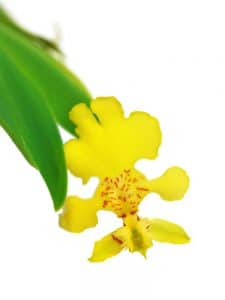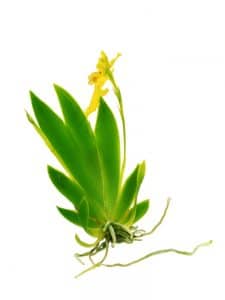Psygmorchis Pusilla is a tiny orchid that enjoys humid environments, making it ideal for bathrooms. Read on to learn about how to care for this Latin American plant.

| Botanical Name | Erycina pusilla |
| Common Name | Tiny Psygmorchis |
| Plant Type | Perennial |
| Flower Color | Several shades of yellow with long flower spikes |
| Size When Mature | 1.5 to 3 inches tall |
| Bloom Time | Autumn to spring |
| Sun Requirements | Bright indirect light |
| USDA Hardiness Zones | 11 |
| Soil pH Range | 5.5 to 6.5 |
| Soil Type | Bare rooted epiphytes that don’t need soil |
| Water Needs | High |
| Native Area | Central and South America |
What You Need To Know About Psygmorchis Pusilla
Psygmorchis pusilla is a small orchid that grows no more than a few inches high. It’s an epiphyte, meaning it grows on the branches of trees and shrubs rather than in the soil.
The orchid produces one-inch flowers, which appear massive relative to its size. The blooms stay out from the fall to the spring. But even when this orchid doesn’t have flowers, you’ll get to enjoy its attractive fan-like leaves.
Psygmorchis pusilla is easy to grow. Unlike most orchids that take years to reach maturity, these plants become mature in a single season.
How To Care for Psygmorchis Pusilla
Below are the must-knows of how to care for your orchid.
Light
Psygmorchis pusilla requires indirect but bright light. If you put it in direct light, its leaves will get sunburned and turn yellow. There’s no need to rotate this plant since it won’t grow toward sunlight.
If you want to place your orchid near a window, use a blind to filter out the light. You can also use artificial light with a setting of 20,000 to 30,000 lux.
Water and Soil Needs
The psygmorchis pusilla doesn’t need soil. Instead, purchasing them on a branch or a piece of cork is common.
That said, some people plant the orchid in potting soil, but you need to ensure it’s well-draining and remains loose around the roots.
You should water your psygmorchis pusilla daily during its active phase, which is the growing season from spring to summer. You can then cut back on watering it in the fall and winter.
It’s best to use reverse osmosis or filtered water for your plant. Ensuring the water runs off it and doesn’t pool at its roots is also crucial. Be careful not to overwater orchids.
Temperature Requirements
Psygmorchis pusilla can only survive in USDA zone 11 in the United States. These plants hail from tropical areas, requiring temperatures in the mid to upper 80s during the summer.
However, these orchids can handle temperatures as cold as 68 degrees in the winter at night as long as the days are warmer.
For this reason, most people only grow psygmorchis pusilla indoors.
Fertilizer
During the months of active growth (spring and summer), you should give your psygmorchis pusilla an orchid-based fertilizer once per week.
But given how small psygmorchis pusillas are, it’s better to use only one-quarter or one-half of the amount the instructions recommend.
Common Diseases
Some of the most common diseases and insect infestations that occur with psygmorchis pusilla include:
- Thrips
- Mites
- Aphids
By providing your psygmorchis pusilla with ideal growing conditions, you’ll reduce the chances of it coming down with a fungal, viral, or pest infection.
Propagation
Since psygmorchis pusilla has a short lifespan, using cuttings from your existing plant for propagating a new plant is vital.
Luckily, doing so is easy. All you need is some tree fern or sphagnum moss. Place the cuttings on this moss, keep the plant well-watered, and before long, roots will form.
